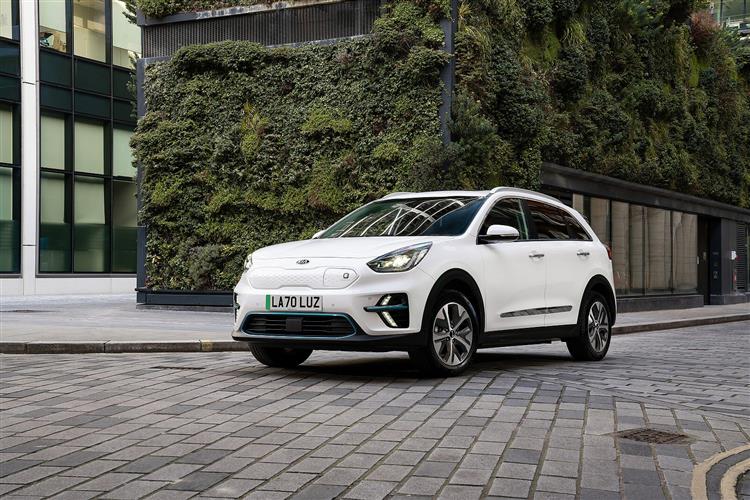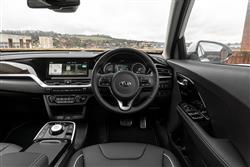AN EV GAME CHANGER (some text hidden) SECTIONED_new_kiaeniro_2019
By Jonathan Crouch
Introductionword count: 87
The family-sized Kia e-Niro, on sale here between 2019 and 2022, was at launch the most complete affordable electric vehicle we had then seen to date. Key to its appeal in 64 kWh form is the kind of driving range you'd expect from a much larger full-electric car - WLTP-rated at 282 miles. Plus the e-Niro is practical, well equipped and easy to adapt to. There are certainly cheaper EV options in this sector from this period. But we're not sure that there are any better ones.
Modelsword count: 7
5DR HATCH (FULL-ELECTRIC [2, 3,4, FIRST EDITION])
Historyword count: 443
If you need a sensible family car and you've decided that some form of electrification needs to be included in your next one, then if you're looking for a used model from the 2019 to 2022 period, the Kia Niro ought to be on your radar. You can have it as a conventional hybrid or a PHEV plug-in hybrid, but it's the full-electric e-Niro model we're going to test here. You might, quite understandably, view the thought of switching from conventional combustion engine motoring to full-electric ownership as being rather a big step to take. Bar stool experts may have put you off EV ownership by telling you that the only full-battery-powered models from this period with a decent driving range are the large luxury segment ones you probably won't be able to afford. Well that's not quite true. At the end of the 21st century's second decade, the Hyundai/Kia Korean conglomerate was pushing boundaries when it came to the kind of battery technology customers could expect from more affordable cars and the result in 2018 was the launch of two models; the Hyundai Kona Electric and its close cousin, this Kia e-Niro, which arrived here in 2019. The e-Niro also shares its battery drivetrain with the second generation version of the model that kicked off Kia's efforts in the EV segment back in 2014, the Soul EV. The first generation Soul EV rather floundered here due to a combination of its relatively high cost and restricted driving range, meaning that only around 500 units were sold in our market in its four years of production. In contrast, this e-Niro model almost doubled that showing in its first month on sale. A big reason behind this sales success lay with the driving range issue mentioned earlier. Most affordable electric vehicles from this period use a battery pack of around 40kWh in size; in most e-Niros though, there was the kind of larger 64kWh battery you'd get in a much larger luxury EV, which means, obviously, a much longer driving range, WLTP-rated at 282 miles. In the EV market's most affordable segment in this period, only the electrically-identical Hyundai Kona Electric and Kia Soul EV models could match this kind of showing and both, though arguably trendier than this Kia, offer significantly less interior space for people and packages. All of which means that if you've been waiting for used battery-powered family cars to get serious, this one should interest you a lot. A smaller 39kWh battery version arrived in 2020. The e-Niro then sold in 64kWh and 39kWh forms until Spring 2022, when it was replaced by a second generation Niro EV model.
What You Getword count: 459
In Kia range terms, the Niro's 4.37m-length positions it somewhere between a Focus-sized Ceed family hatch and a Qashqai-style mid-size Sportage SUV. The car is nominally an SUV (in this case, Kia prefers the term 'Crossover'), hence the chunky stance, the integrated roof rails and muscular wheel arches that on high-spec versions house large 17-inch diamond-cut two-tone aluminium rims. Conventional-looking EVs are often compromised in their basic design by the need - in other forms - to accommodate a bulky combustion engine. But all Niro variants feature electrification to some extent and the priority with this one was to incorporate its bulky battery pack in a way that had as little impact as possible on cabin space. At the wheel, key change from a Niro Hybrid to an e-Niro lies with the installation of a rotary gear selector dial for the single-speed auto gearbox. This frees up a useful extra lidded storage space between (on top models) heated, powered and leather-upholstered front seats that were redesigned to save space and weight. More subtle differences can be found incorporated into the 8-inch centre-dash infotainment touchscreen, which allows you to locate nearby charging points and set departure times to pre-heat and pre-cool the cabin. This display also has all the usual connectivity and entertainment features too of course. So there's navigation, voice control, 'Apple CarPlay'/'Android Auto' smartphone-mirroring, Bluetooth and an 8-speaker 320-watt JBL premium sound system with a DAB tuner. Plus you get the full suite of 'Kia Connected Services'. Most other key functions are covered off by the instrument display you view through the leather-stitched three-spoke steering wheel, this cluster incorporating a mixture of circular LED dials and a central 7-inch LCD screen. Back seat space is probably the biggest difference between this car and its Hyundai Kona Electric cousin, which offers a significantly smaller rear compartment with 90mm less leg space. Perhaps just as significant is the fact that this e-Niro offers slightly more rear passenger room than most more affordable conventional 'C'-segment family SUVs - Kia's mid-sized Sportage Crossover for instance, which may be lengthier externally but has a wheelbase 30mm shorter. You'll fit in three adults in the back slightly more easily than would be the case with most similarly-sized rival models; that's thanks to the way that the relatively wide 1,805mm body provides 1,402mm of shoulder room. Swing up the large tailgate and you'll find a very generously-proportioned boot that's usefully square in shape and 451-litres in size, which is 69-litres more than you get on the self-charging hybrid variant and a massive 127-litres more than is offered by the PHEV Niro model. That's better than you'd get from most family hatchbacks and pretty close to the luggage capacity you'd enjoy with a conventionally-engined family SUV.
To see the full road test text contact us on 0330 0020 227
Pictures (high res disabled)

.jpg)
|
.jpg)
|
.jpg)
| |||
.jpg)
|
.jpg)
|
.jpg)
| |||
.jpg)
|
.jpg)
|
.jpg)
| |||
.jpg)
|
.jpg)
|

|
Scoring (subset of scores)
Category: Hybrid, Plug-in, Electric & Hydrogen
| Performance | |
| Handling | |
| Comfort | |
| Space | |
| Styling, Build, Value, Equipment, Depreciation, Handling, Insurance and Total scores are available with our full data feed. | |



